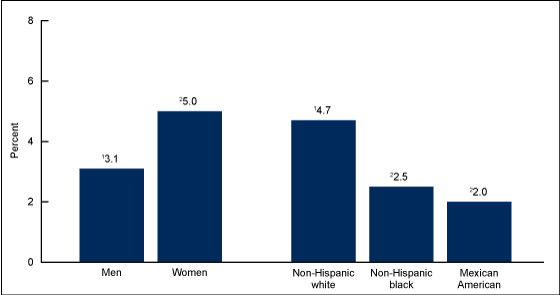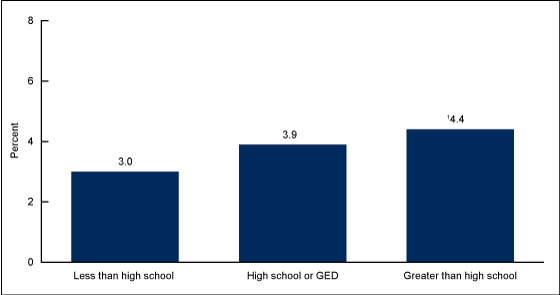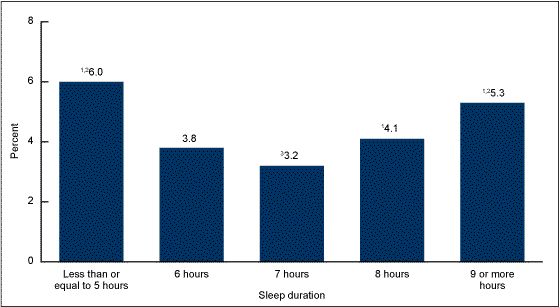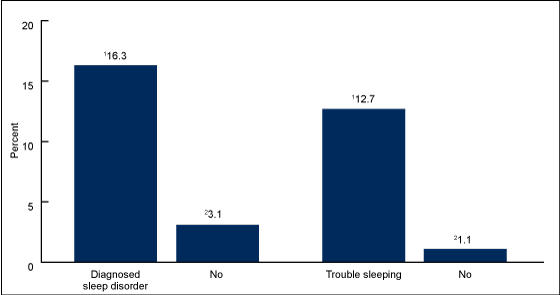Prescription Sleep Aid Use Among Adults: United States, 2005–2010
On This Page
- Key findings
- Prescription sleep aid use in the past 30 days increased with age.
- Prescription sleep aid use in the past 30 days varied by sex and race and ethnicity.
- Prescription sleep aid use in the past 30 days increased with higher education.
- Prescription sleep aid use in the past 30 days varied by sleep duration
- Prescription sleep aid use in the past 30 days was higher among adults with diagnosed sleep disorders and among adults with trouble sleeping.
- Summary
- Definitions
- Data source and methods
- About the authors
- References
- Suggested citation
NCHS Data Brief No. 127, August 2013
PDF Version (1.2 MB)
Yinong Chong, Ph.D.; Cheryl D. Fryar, M.S.P.H.; and Qiuping Gu, M.D., Ph.D.
Key findings
Data from the National Health and Nutrition Examination Survey, 2005–2010
- About 4% of U.S. adults aged 20 and over used prescription sleep aids in the past month.
- The percentage of adults using a prescription sleep aid increased with age and education. More adult women (5.0%) used prescription sleep aids than adult men (3.1%).
- Non-Hispanic white adults were more likely to use sleep aids (4.7%) than non-Hispanic black (2.5%) and Mexican-American (2.0%) adults.
- Prescription sleep aid use varied by sleep duration and was highest among adults who sleep less than 5 hours (6.0%) or sleep 9 or more hours (5.3%).
- One in six adults with a diagnosed sleep disorder and one in eight adults with trouble sleeping reported using sleep aids.
Sedative and hypnotic medications, often referred to as sleep aids, are used to induce or maintain sleep by suppressing activities in the central nervous system. In the past two decades, both popular media and pharmaceutical companies have reported an increased number of prescriptions filled for sleep aids in the United States (1,2). In fact, a market research firm has reported a tripling in sleep aid prescriptions from 1998 to 2006 for young adults aged 18–24 (3). This report presents person-based nationally representative estimates on prescription sleep aid use in the past 30 days, describes sociodemographic differences in use, and examines sleep aid use by self-reported sleep duration and insomnia.
Keywords: hypnotic medications, sleeping pills, insomnia, National Health and Nutrition Examination Survey
Prescription sleep aid use in the past 30 days increased with age.
Figure 1. Percentage of adults aged 20 and over who used prescription sleep aids in the past 30 days, by age: United States, 2005–2010
1Significant increasing linear trend by age (p < 0.05).
NOTE: Sleep aids include all hypnotic drugs and four antidepressant or sedative medications commonly prescribed for insomnia or depression.
SOURCE: CDC/NCHS, National Health and Nutrition Examination Survey.
During 2005–2010, about 4% of U.S. adults aged 20 and over reported that they took prescription sleep aids in the past 30 days. Prevalence of use was lowest among the youngest age group (those aged 20–39) at about 2%, increased to 6% among those aged 50–59, and reached 7% among those aged 80 and over (Figure 1).
Prescription sleep aid use in the past 30 days varied by sex and race and ethnicity.
Reported prescription sleep aid use in the past 30 days was higher among women (5.0%) than men (3.1%). Non-Hispanic white adults reported higher use of sleep aids (4.7%) than non-Hispanic black (2.5%) and Mexican-American (2.0%) adults. No difference was shown between non-Hispanic black adults and Mexican-American adults in use of prescription sleep aids (Figure 2).
Figure 2. Age-adjusted percentage of adults aged 20 and over who used prescription sleep aids in the past 30 days, by sex and race and ethnicity: United States, 2005–2010
1Reference group.
2Significantly different from reference group (p < 0.05).
NOTES: Data are age-adjusted to the 2000 projected U.S. standard population using the age groups 20–39, 40–59, and 60 and over. Sleep aids include all hypnotic drugs and four antidepressant or sedative medications commonly prescribed for insomnia or depression.
SOURCE: CDC/NCHS, National Health and Nutrition Examination Survey.
Prescription sleep aid use in the past 30 days increased with higher education.
Three percent of adults with less than a high school education reported using sleep aids in the past 30 days, compared with 3.9% with a high school diploma and 4.4% of adults with greater than a high school education (Figure 3).
Figure 3. Age-adjusted percentage of adults aged 20 and over who used prescription sleep aids in the past 30 days, by education: United States, 2005–2010
1Significant increasing linear trend by education (p < 0.05).
NOTES: GED is General Educational Development high school equivalency diploma. Data are age-adjusted to the 2000 projected U.S. standard population using the age groups 20–39, 40–59, and 60 and over. Sleep aids include all hypnotic drugs and four antidepressant or sedative medications commonly prescribed for insomnia or depression.
SOURCE: CDC/NCHS, National Health and Nutrition Examination Survey.
Prescription sleep aid use in the past 30 days varied by sleep duration.
The National Sleep Foundation suggests that 7 hours of sleep is the minimum amount of sleep that adults need on a regular basis for optimal performance (4), thus 7 hours is used as the reference point for sleep duration. Compared with those who reported 7 hours of sleep (3.2%), adults with 5 or fewer hours of sleep per night had the highest use of sleep aids in the past 30 days (6.0%). Those with 6 hours of sleep (3.8%) did not significantly differ from the reference group, whereas those with 8 hours (4.1%) or 9 or more hours (5.3%) of sleep showed higher usage of sleep aids. In other words, when sleep duration was greater or less than 7 hours, the use of sleep aids increased (Figure 4).
Figure 4. Age-adjusted percentage of adults aged 20 and over who used prescription sleep aids in the past 30 days, by sleep duration: United States, 2005–2010
1Significantly different from reference group (p < 0.05).
2Significant quadratic trend with sleep duration (p < 0.05).
3Reference group.
NOTES: Data are age-adjusted to the 2000 projected U.S. standard population using the age groups 20–39, 40–59, and 60 and over. Sleep aids include all hypnotic drugs and four antidepressant or sedative medications commonly prescribed for insomnia or depression.
SOURCE: CDC/NCHS, National Health and Nutrition Examination Survey.
Prescription sleep aid use in the past 30 days was higher among adults with diagnosed sleep disorders and among adults with trouble sleeping.
Over 16% of adults who reported a physician’s diagnosis of a sleep disorder reported using sleep aids in the past 30 days, which was more than five times higher than those who did not report such a diagnosis. About 13% of adults who told their doctor that they had trouble sleeping reported sleep aid use, which was nearly 12 times higher than those who did not report any trouble sleeping (Figure 5).
Figure 5. Age-adjusted percentage of adults aged 20 and over who used prescription sleep aids in the past 30 days, by physician-diagnosed sleep disorder and self-reported trouble going to sleep: United States, 2005–2010
1Significantly different from reference group (p < 0.05).
2Reference group.
NOTES: Data are age-adjusted to the 2000 projected U.S. standard population using the age groups 20–39, 40–59, and 60 and over. Sleep aids include all hypnotic drugs and four antidepressant or sedative medications commonly prescribed for insomnia or depression.
SOURCE: CDC/NCHS, National Health and Nutrition Examination Survey.
Summary
According to estimates, 50–70 million Americans suffer from sleep disorders or deprivation (5), which can not only hinder daily functioning, but can also adversely affect their health (6,7). Prescription sleep aids are one of the treatment options for trouble going into or maintaining sleep. However, long-term use of sleep aids has been linked to adverse outcomes in health (8).
So far, studies on sleep aid use are mostly based on administrative claims data, which describe the number of times sleep aid prescriptions are filled rather than how many people have actually used prescription sleep aids. This report provides the first person-based national data on prescription sleep aid use among the noninstitutionalized U.S. adult population. Approximately 4% of adults aged 20 and over reported using a prescription sleep aid in the past month. Use increased with age and was more common among women, non-Hispanic white adults, and those with greater than a high school education. Use also varied by sleep duration and was significantly higher among adults who reported sleep disorders or trouble sleeping.
Definitions
Prescription sleep aid users: Respondents who reported using any of the following hypnotic drugs in the past 30 days were classified as prescription sleep aid users: butabarbital, chloral hydrate, estazolam, eszopiclone, flurazepam, quazepam, ramelteon, temazepam, triazolam, zaleplon, and zolpidem. Respondents who reported using any of the following antidepressant drugs with sedative function in the past 30 days were also included as sleep aid users: amitriptyline, doxepin, mirtazapine, and trazodone. Although these latter drugs are not FDA-approved as primary medications for insomnia, their sedative effects make them frequently prescribed by clinicians for treating patients with both depression and sleep disorders (9).
Education: Respondent’s education is based on self-reported education level and classified into three categories: less than high school, completed high school or general equivalency diploma, and greater than high school education.
Diagnosed sleep disorder: Defined by an affirmative answer to the question “Have you ever been told by a doctor or other health professional that you have a sleep disorder?”
Trouble sleeping: Defined by an affirmative answer to the question “Have you ever told a doctor or other health professional that you have trouble sleeping?”
Data source and methods
The National Health and Nutrition Examination Survey is a cross-sectional survey with a complex, multistage sample design. The sample design includes oversampling to obtain reliable estimates of health and nutritional measures for population subgroups. The survey consists of interviews conducted in participants’ homes and standardized physical examinations.
During the home interview, survey participants were asked if they have taken a prescription drug in the past 30 days. Those who answered yes were asked to show the interviewer the medication containers of all prescription drugs. For each medication, the interviewer recorded the product’s complete name from the container. All reported medication names were converted to a standard generic name.
This report is based on interview data conducted at respondents’ homes, therefore, interview sample weights, which account for the differential probabilities of selection, nonresponse, and noncoverage, were incorporated into the estimation process. The standard errors of the percentages were estimated using Taylor series linearization, a method that incorporates the sample design. Prevalence estimates were age-adjusted to the projected 2000 U.S. standard population using the following age groups: 20–39, 40–59, and 60 and over. Differences between groups were evaluated using a t statistic at the p < 0.05 significance level. Statistical hypotheses of no linear or quadratic trends were tested using orthogonal polynomials. All differences reported are statistically significant unless otherwise indicated. Statistical analyses were conducted using the SAS System for Windows (release 9.2; SAS Institute Inc., Cary, N.C.) and SUDAAN (release 10.0; RTI International, Research Triangle Park, N.C.).
About the authors
Yinong Chong, Cheryl D. Fryar, and Qiuping Gu are with the Centers for Disease Control and Prevention’s National Center for Health Statistics, Division of Health and Nutrition Examination Surveys.
References
- Sleeping pill use grows as economy keeps people up at night. LA Times. 2009.
- Cascade E, Kalali AH, Kwentus JA, Bharmal M. Trends in CNS prescribing following the economic slowdown. Psychiatry 6(1):15–77. 2009.
- Russo A, Miller K, Marder W. Prescription sleep aid use in young adults. Thomson Reuters Research Brief. 2008.
- National Sleep Foundation. How much sleep do we really need?
- Institute of Medicine. Sleep disorders and sleep deprivation: An unmet public health problem. 2006.
- CDC. Effect of short sleep duration on daily activities—United States, 2005–2008. MMWR 60(8):239–42. 2011.
- van Cauter E, Holmback U, Knutson K, Leproult R, Miller A, Nedeltcheva A, et al. Impact of sleep and sleep loss on neuroendocrine and metabolic function. Horm Res 67 Suppl 1:2–9. 2007.
- Kripke DF, Langer RD, Kine LE. Hypnotics’ association with mortality or cancer: A matched cohort study. BMJ Open 2(1):e000850. 2012.
- Mayo Clinic. Prescription sleeping pills: What’s right for you?
Suggested citation
Chong Y, Fryar CD, Gu Q. Prescription sleep aid use among adults: United States, 2005–2010. NCHS data brief, no 127. Hyattsville, MD: National Center for Health Statistics. 2013.
Copyright information
All material appearing in this report is in the public domain and may be reproduced or copied without permission; citation as to source, however, is appreciated.
National Center for Health Statistics
Charles J. Rothwell, M.S., Acting Director
Jennifer H. Madans, Ph.D., Associate Director for Science
Division of Health and Nutrition Examination Surveys
Kathryn S. Porter, M.D., M.S., Director
- Page last reviewed: November 6, 2015
- Page last updated: August 29, 2013
- Content source:


 ShareCompartir
ShareCompartir




